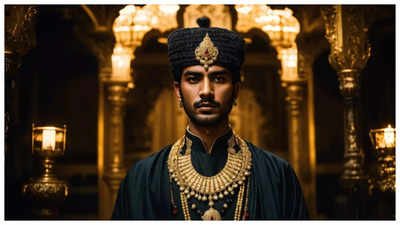- News
- Nawabs of Awadh and their hunting expeditions
Nawabs of Awadh and their hunting expeditions
Nawab Asif-ud-Daulah, known for his archery skill, led huge hunting parties divided into sections for hunting and entertainment, including soldiers, elephants, hawks, leopards, acrobats, and poets.

(Lexica generated AI image)
By Ravi Bhatt
Hunting parties of the Nawabs of Awadh were more of an occasion to move away from the monotonous life of the court rather than only hunting.
Nawab Asif-ud-Daulah, who built Bada Imambara, was “good at the skill of archery”, according to the ‘History of Asif-ud-Daulah’.
His huge hunting party was divided into two parts. One consisted of things required for hunting and the other for the usual entertainment of the Nawab.The first section had about 10,000 soldiers on horses and foot, about 800 elephants, well trained hawks for hunting birds in flight, and dogs and leopards for hunting deer and bucks.
The second section included acrobats, enchanting dancing girls, singers, poets and men carrying huge blocks of ice. According to author Nisar Ahmad Farooqui, on one such expedition to a forest near Bahraich in 1783, even great poet Mir Taqi Mir accompanied Asif-ud-Dulah and wrote a poem ‘Shikarnama’ about the Nawab’s hunting expedition. Mir also went with the Nawab to a forest adjoining Pilibhit where he penned another poem.
Apart from this regular activity, a much bigger group which included a kind of market moving behind Nawab’s party in its own interest.
Daniel Johnson writes in his work ‘Sketches of Field Sports’ that it appeared like a large army going to a battlefield.
During actual hunting, the Nawab’s people would form a big circle in the jungle on horseback and then slowly start closing in, thus animals would be forced to collect at a desired place where already waiting Nawab could easily shoot them. It was like presenting the animal on a plate for hunting.
(The writer is a well-known historian and the author of ‘The Life and Times of the Nawabs of Lucknow’)
Hunting parties of the Nawabs of Awadh were more of an occasion to move away from the monotonous life of the court rather than only hunting.
Nawab Asif-ud-Daulah, who built Bada Imambara, was “good at the skill of archery”, according to the ‘History of Asif-ud-Daulah’.
His huge hunting party was divided into two parts. One consisted of things required for hunting and the other for the usual entertainment of the Nawab.The first section had about 10,000 soldiers on horses and foot, about 800 elephants, well trained hawks for hunting birds in flight, and dogs and leopards for hunting deer and bucks.
How much pain was taken to train these animals could be gauged from the fact that leopards, while hunting deer or buck, used to only kill the prey but not eat them.
The second section included acrobats, enchanting dancing girls, singers, poets and men carrying huge blocks of ice. According to author Nisar Ahmad Farooqui, on one such expedition to a forest near Bahraich in 1783, even great poet Mir Taqi Mir accompanied Asif-ud-Dulah and wrote a poem ‘Shikarnama’ about the Nawab’s hunting expedition. Mir also went with the Nawab to a forest adjoining Pilibhit where he penned another poem.
Apart from this regular activity, a much bigger group which included a kind of market moving behind Nawab’s party in its own interest.
Daniel Johnson writes in his work ‘Sketches of Field Sports’ that it appeared like a large army going to a battlefield.
During actual hunting, the Nawab’s people would form a big circle in the jungle on horseback and then slowly start closing in, thus animals would be forced to collect at a desired place where already waiting Nawab could easily shoot them. It was like presenting the animal on a plate for hunting.
(The writer is a well-known historian and the author of ‘The Life and Times of the Nawabs of Lucknow’)
End of Article
FOLLOW US ON SOCIAL MEDIA
